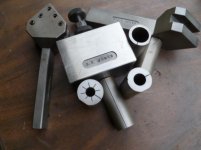What you have is a simple drill press vise. It was likely made as a high school machine shop project by a student whose initials were "JEM". A drill press vise of this sort of design was a fairly standard item in books of machine shop projects for HS students.
A toolmaker apprentice would more likely have made a vise for holding work for precision grinding- requiring hardened, ground, and lapped parts. Toolmaker apprentices tended to make tooling like vee blocks, 1-2-3 blocks, and grinder vises. All of these required a much high degree of precision than a drill press vise. A drill press vise is a fairly elementary project, not calling for anything like close tolerance work not hardening and grinding and final lapping.
Looking at the "blocky" lines of this vise, my guess is some HS student hogged it out of chunks of bar stock, probably on a shaper or horizontal mill, as would have been typical for the 1950's.
A toolmaker's vise is a bit more refined, and would have lower jaw heights and be hardened and ground. This vise has some "dings" and scratches in the steel, so is unhardened, nor was it ever finish ground. It was polished with emery cloth and then possibly on a canvas wheel charged with emery compound, judging by the finish.
I had a HS senior as a kind of "apprentice" in my own shop a few years ago. One project I threw at him was to make himself a drill press vise. What I did was to stick weld some pieces of hot rolled A-36 steel together to make the body and moveable jaw. I then stress relieved these parts in the coal bed in my heating boiler, letting them slow cool in a bucket of ashes. I needle scaled these parts, and also annealed a piece of scrap 1060 highway snow plow cutting edge steel for vise caps, along with a chunk of axle steel for the screw. I handed my apprentice this heap of pieces and a working drawing I'd made and turned him loose. I worked him through building the vise. He made jaw plates with vee grooves milled in them from the 1060 snow plow cutting edge steel, finishing them on my surface grinder. He cut the screw thread for the vise screw, and had to figure what his reference surfaces were, and his setups. He wound up with a nice drill press vise he will likely use the rest of his career as he is in a NY State college studying what is a two year program for future machinists and toolmakers.
Friends who are real toolmakers rather than oldtime machinists (me), tended to make hardened and ground tooling during their apprenticeships. One fellow described making a toolmaker's vise over a winter. He'd machine some on the the steel, then when his wife was baking or cooking food in the oven, he'd put the vise parts in. After the oven cooled, he'd put the parts out in the winter weather for a day or two, then back into the oven, or back to the shop for more machining. The oldtimers took their time with these sorts of projects, likening it to making "Jo Blocks", needing to wait for the steel molecules to "stablize", and using the heating and freezing cycling in between machinings and grindings to help that process along. When a toolmaker apprentice made a vise of 1-2-3 blocks or similar, the workmanship was a lot finer, and the signs of heat treating and precision grinding and lapping would be there. A toolmaker apprentice would also, typically, end-mill a shallow slot in which he'd stamp his initials and date. The reason for this was to keep the "raised up" steel from the stampings, and the resulting stress risers, out of the finished surfaces. The initials and date stampings would usually appear black or gray from the heat treating. I've got some tooling made by toolmaker apprentices, as well having had friends who served their time in toolmaker's apprenticeships show me the tooling they made during their own apprenticeships. Sorry to disagree, but this looks like a HS or possibly a community college shop class project.


